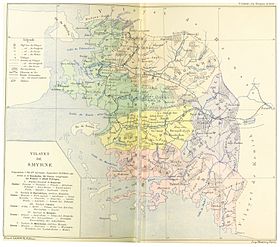Vilayet of İzmir
|
ولايت ايدين Vilâyet-i Aidin (Velâyat-e Aydın) |
|||||
| Vilayet of the Ottoman Empire | |||||
|
|||||
| Aidin Vilayet in 1894 | |||||
| Capital | Smyrna (Izmir) | ||||
| History | |||||
| • | Established | 1867 | |||
| • | Disestablished | 1922 | |||
| Today part of |
|
||||
The Vilayet of Aidin or Aydin (Ottoman Turkish: ولايت ايدين, translit. Vilâyet-i Aidin), also known as Vilayet of Smyrna or Izmir after its administrative centre, was a first-level administrative division (vilayet) of the Ottoman Empire in the south-west of Asia Minor, including the ancient regions of Lydia, Ionia, Caria and western Lycia. It was described by the 1911 Encyclopædia Britannica as the "richest and most productive province of Asiatic Turkey".
At the beginning of the 20th century it reportedly had an area of 17,370 square miles (45,000 km2), while the preliminary results of the first Ottoman census of 1885 (published in 1908) gave the population as 1,390,783. The stated accuracy of the population figures ranges from "approximate" to "merely conjectural" depending on the region from which they were gathered. As of 1920, the vilayet had a "exceptionally large" Christian population.
The British described Aidin Vilayet as having a "remarkable variety of agriculture", as of 1920. They produced grains and cotton, specifically in Aydın and Nazilli. The region also produced opium, tobacco, and valonia oak. Fruit was one of the most popular exports, with figs and grapes being popular. Before World War I, fig production was up, with an expansive increase in production and exportation via railway. Grapes were used to produce raisins and licorice was also produced in the region. It was noted as growing wild along the Büyük Menderes River. It was exported to the United States and United Kingdom.
...
Wikipedia

